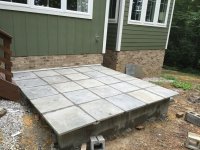s219
Super Member
- Joined
- Dec 7, 2011
- Messages
- 8,608
- Location
- Virginia USA
- Tractor
- Kubota L3200, Deere X380, Kubota RTV-X
I found that when using mortar to attach stone, it needs to be on the wet side. From what you describe, I think your mortar was too dry. I'm guessing that you spread it all out at the same time, then laid the stone on top of it. The first few stones are probably fine, but the last few are the ones that are coming off easily.
The moisture isn't important, but there was no reason to put plastic over it.
In the last couple of years I've gone from dealing with the short working time of mortar to the much better and stronger bond of using regular thinset mortar that everyone uses for tile. I also back butter each tile, or stone. This controls the mess, and there is never a dry spot in the mortar. If the surface is porous, like tiling over brick or block, I skim coat that too.
Do you have a SDS rotary hammer with a flat chisel bit? I would use that to clean off the existing mortar and start over fresh.
We used a recipe specifically recommended for laying flagstones, and it was mixed as we went -- each batch was good for about 2 stones (~ 8 sq.ft). It was about as wet as normal mortar I'd say. We sponged down the slab and stone before setting, to prevent them from pulling moisture from the mortar too quickly. Did everything by the book as far as I can tell.
I talked to a mason today, and he said if the mortar bed is solid and well-attached, which I confirmed it is, then either use modified thin set or a product called Laticrete "Latapoxy" to reset the stones down on the existing mortar bed. The Latapoxy is expensive, but very certain to work, so I may go that route.
